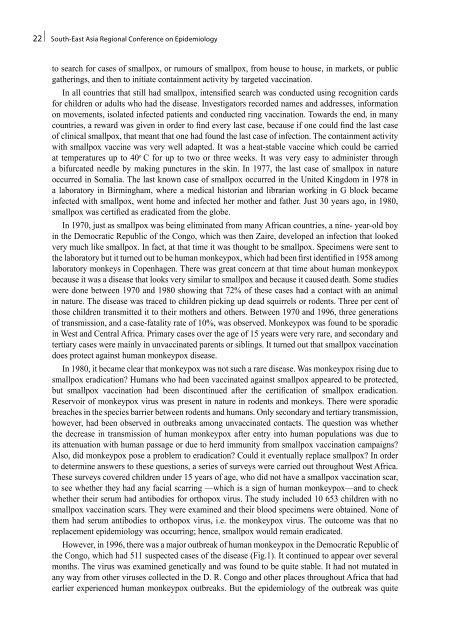South-East Asia Regional Conference on Epidemiology
South-East Asia Regional Conference on Epidemiology
South-East Asia Regional Conference on Epidemiology
You also want an ePaper? Increase the reach of your titles
YUMPU automatically turns print PDFs into web optimized ePapers that Google loves.
22 | <str<strong>on</strong>g>South</str<strong>on</strong>g>-<str<strong>on</strong>g>East</str<strong>on</strong>g> <str<strong>on</strong>g>Asia</str<strong>on</strong>g> <str<strong>on</strong>g>Regi<strong>on</strong>al</str<strong>on</strong>g> <str<strong>on</strong>g>C<strong>on</strong>ference</str<strong>on</strong>g> <strong>on</strong> <strong>Epidemiology</strong><br />
to search for cases of smallpox, or rumours of smallpox, from house to house, in markets, or public<br />
gatherings, and then to initiate c<strong>on</strong>tainment activity by targeted vaccinati<strong>on</strong>.<br />
In all countries that still had smallpox, intensified search was c<strong>on</strong>ducted using recogniti<strong>on</strong> cards<br />
for children or adults who had the disease. Investigators recorded names and addresses, informati<strong>on</strong><br />
<strong>on</strong> movements, isolated infected patients and c<strong>on</strong>ducted ring vaccinati<strong>on</strong>. Towards the end, in many<br />
countries, a reward was given in order to find every last case, because if <strong>on</strong>e could find the last case<br />
of clinical smallpox, that meant that <strong>on</strong>e had found the last case of infecti<strong>on</strong>. The c<strong>on</strong>tainment activity<br />
with smallpox vaccine was very well adapted. It was a heat-stable vaccine which could be carried<br />
at temperatures up to 40o C for up to two or three weeks. It was very easy to administer through<br />
a bifurcated needle by making punctures in the skin. In 1977, the last case of smallpox in nature<br />
occurred in Somalia. The last known case of smallpox occurred in the United Kingdom in 1978 in<br />
a laboratory in Birmingham, where a medical historian and librarian working in G block became<br />
infected with smallpox, went home and infected her mother and father. Just 30 years ago, in 1980,<br />
smallpox was certified as eradicated from the globe.<br />
In 1970, just as smallpox was being eliminated from many African countries, a nine- year-old boy<br />
in the Democratic Republic of the C<strong>on</strong>go, which was then Zaire, developed an infecti<strong>on</strong> that looked<br />
very much like smallpox. In fact, at that time it was thought to be smallpox. Specimens were sent to<br />
the laboratory but it turned out to be human m<strong>on</strong>keypox, which had been first identified in 1958 am<strong>on</strong>g<br />
laboratory m<strong>on</strong>keys in Copenhagen. There was great c<strong>on</strong>cern at that time about human m<strong>on</strong>keypox<br />
because it was a disease that looks very similar to smallpox and because it caused death. Some studies<br />
were d<strong>on</strong>e between 1970 and 1980 showing that 72% of these cases had a c<strong>on</strong>tact with an animal<br />
in nature. The disease was traced to children picking up dead squirrels or rodents. Three per cent of<br />
those children transmitted it to their mothers and others. Between 1970 and 1996, three generati<strong>on</strong>s<br />
of transmissi<strong>on</strong>, and a case-fatality rate of 10%, was observed. M<strong>on</strong>keypox was found to be sporadic<br />
in West and Central Africa. Primary cases over the age of 15 years were very rare, and sec<strong>on</strong>dary and<br />
tertiary cases were mainly in unvaccinated parents or siblings. It turned out that smallpox vaccinati<strong>on</strong><br />
does protect against human m<strong>on</strong>keypox disease.<br />
In 1980, it became clear that m<strong>on</strong>keypox was not such a rare disease. Was m<strong>on</strong>keypox rising due to<br />
smallpox eradicati<strong>on</strong>? Humans who had been vaccinated against smallpox appeared to be protected,<br />
but smallpox vaccinati<strong>on</strong> had been disc<strong>on</strong>tinued after the certificati<strong>on</strong> of smallpox eradicati<strong>on</strong>.<br />
Reservoir of m<strong>on</strong>keypox virus was present in nature in rodents and m<strong>on</strong>keys. There were sporadic<br />
breaches in the species barrier between rodents and humans. Only sec<strong>on</strong>dary and tertiary transmissi<strong>on</strong>,<br />
however, had been observed in outbreaks am<strong>on</strong>g unvaccinated c<strong>on</strong>tacts. The questi<strong>on</strong> was whether<br />
the decrease in transmissi<strong>on</strong> of human m<strong>on</strong>keypox after entry into human populati<strong>on</strong>s was due to<br />
its attenuati<strong>on</strong> with human passage or due to herd immunity from smallpox vaccinati<strong>on</strong> campaigns?<br />
Also, did m<strong>on</strong>keypox pose a problem to eradicati<strong>on</strong>? Could it eventually replace smallpox? In order<br />
to determine answers to these questi<strong>on</strong>s, a series of surveys were carried out throughout West Africa.<br />
These surveys covered children under 15 years of age, who did not have a smallpox vaccinati<strong>on</strong> scar,<br />
to see whether they had any facial scarring —which is a sign of human m<strong>on</strong>keypox—and to check<br />
whether their serum had antibodies for orthopox virus. The study included 10 653 children with no<br />
smallpox vaccinati<strong>on</strong> scars. They were examined and their blood specimens were obtained. N<strong>on</strong>e of<br />
them had serum antibodies to orthopox virus, i.e. the m<strong>on</strong>keypox virus. The outcome was that no<br />
replacement epidemiology was occurring; hence, smallpox would remain eradicated.<br />
However, in 1996, there was a major outbreak of human m<strong>on</strong>keypox in the Democratic Republic of<br />
the C<strong>on</strong>go, which had 511 suspected cases of the disease (Fig.1). It c<strong>on</strong>tinued to appear over several<br />
m<strong>on</strong>ths. The virus was examined genetically and was found to be quite stable. It had not mutated in<br />
any way from other viruses collected in the D. R. C<strong>on</strong>go and other places throughout Africa that had<br />
earlier experienced human m<strong>on</strong>keypox outbreaks. But the epidemiology of the outbreak was quite









